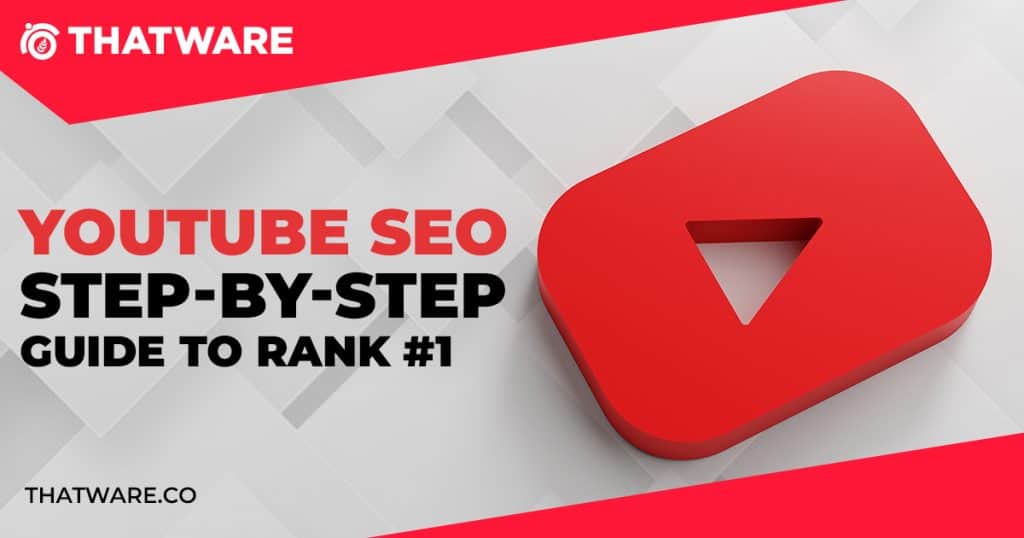SUPERCHARGE YOUR ONLINE VISIBILITY! CONTACT US AND LET’S ACHIEVE EXCELLENCE TOGETHER!
The only search engine larger than YouTube is that of its parent company, Google. YouTube videos make up eight out of ten of the results for video searches, and the site is constantly expanding with more than 500 hours of new content being added every minute. What can you do to keep from getting lost in the sea of videos? Utilizing best practices for video SEO, your best bet is to optimize excellent videos for search. You can build a strong YouTube SEO strategy using these recommendations.
Mastering YouTube: Unveiling the Secrets of Video SEO Domination
Here in this section of the article we will talk about, what is youtube seo and explain its process. YouTube SEO, or YouTube Search Engine Optimization, is the practice of optimizing your video content to improve its visibility and ranking on YouTube’s search engine results pages (SERPs). Unlike traditional SEO for websites, YouTube SEO involves a unique set of strategies tailored specifically for video content. The process of YouTube SEO encompasses various elements, starting from keyword research to monitoring analytics. Here’s a breakdown of the key components and steps involved in optimizing your videos for YouTube:
Keyword Research: Just like with traditional SEO, keyword research is fundamental to YouTube SEO. You need to identify relevant keywords and phrases that your target audience is likely to use when searching for content similar to yours. Tools like UberSuggest, VidIQ Vision, and Moz Keyword Explorer can help you discover popular keywords and assess their search volume and competition.
Optimizing Video Elements: Once you’ve selected your target keywords, it’s essential to optimize various elements of your video to include those keywords. This includes the video title, description, tags, and even the video file name. Incorporating keywords naturally into these elements helps YouTube’s algorithm understand the content of your video and improves its chances of ranking for relevant searches.
Closed Captions and Transcripts: Adding accurate closed captions and transcripts to your videos not only enhances accessibility but also boosts SEO. Search engines can crawl and index text, so providing captions and transcripts rich in keywords helps improve your video’s visibility. Additionally, transcripts can be repurposed for other content formats, such as blog posts or infographics, further extending your content’s reach.
Language Optimization: To reach a global audience, consider providing subtitles in multiple languages. Translating your captions broadens your viewership and can improve your ranking in non-English search results, where competition may be lower. By catering to diverse linguistic preferences, you increase the likelihood of your videos being discovered by international audiences.
Compelling Thumbnails: Thumbnails play a crucial role in attracting viewers and encouraging clicks. Choose high-quality, visually appealing thumbnails that accurately represent your video’s content. Incorporating elements related to your target keyword can also help your thumbnail stand out in search results and attract more clicks.
Engagement and User Experience: Engagement metrics such as likes, comments, shares, and watch time are vital signals that influence YouTube’s ranking algorithm. Encourage audience interaction and feedback by responding to comments, asking questions, and fostering community engagement. Focus on creating valuable, engaging content that resonates with your audience and keeps them coming back for more.
Analytics and Monitoring: Regularly monitor your video analytics to track the performance of your YouTube SEO efforts. Key metrics to watch include watch time, click-through rates, subscriber growth, and traffic sources. Analyzing these metrics allows you to identify trends, optimize your content strategy, and refine your SEO tactics for better results.
YouTube SEO is a multifaceted process that involves optimizing various aspects of your video content to improve its visibility, engagement, and ranking on YouTube’s platform. By understanding and implementing these strategies effectively, you can enhance the discoverability of your videos and grow your audience on YouTube.

⭐ What exactly is a YouTube SEO plan?
Designing web content to rank highly on search engine results pages is a constantly evolving process known as search engine optimization (SEO) (SERPs). Optimizing your content for search is essential to generating traffic and expanding your audience because search is frequently the gatekeeper to your content.
YouTube SEO entails optimizing your channel, playlists, metadata, descriptions, and videos, unlike Google, which evaluates rank based on backlinks and other factors. Your videos can be made search-engine-friendly both inside and outside of YouTube.
You might be familiar with the fundamentals of SEO for YouTube videos, such as using keywords in the channel name, meta description, and tags. But there’s more you can do for YouTube SEO by making videos more accessible. Since search engine bots are unable to view videos, they must be properly indexed using the accompanying text information. Utilizing the text in your video in the form of transcripts, closed captions, and subtitles is a crucial part of a YouTube SEO strategy because it can have a positive impact on user experience, engagement, watch time, viewership, and SEO.
Ten suggestions are provided here for increasing views and improving your YouTube SEO.
⭐Pick a powerful keyword
The right keyword or phrase must be chosen for your video before you can improve YouTube SEO. Keywords frequently appear in video titles, metadata, captions, and transcripts when they are spoken in the audio. That’s advantageous for SEO.
The words and phrases you choose for your keywords and keyword phrases should
a) Accurately describe your video, and
b) Be similar to what people type into search engines to find content like yours.
You’ll need to conduct some keyword research to learn what terms and phrases people use when searching. Using YouTube’s Search Suggest feature to find a keyword for your video is a simple strategy. Enter a word or phrase that is pertinent to your industry in the search bar to see what YouTube suggests.
In the YouTube Studio’s Traffic Sources > YouTube search section, you can also find keywords from your YouTube search report.
Look at how many “About” results your keyword produces when you search for it on YouTube to see if it’s a good one. In order to stand out from the crowd, you should look for keyword variations with a high search volume but low competition.
Though choosing the best keyword is easier said than done, many tools are available to assist. Some of the popular tools are:
- UberSuggest,
- VidIQ Vision,
- Moz Keyword Explorer,
- AdWords Keyword Planner
With the help of these tools, you can investigate additional data such as keyword volume, which represents the quantity of monthly Google searches for the keyword, and cost per click, which represents the typical cost per click for the term on Google Ads.
Once you’ve chosen a strong keyword, make sure YouTube is aware of it by including it in the file name of your video.
⭐Add accurate closed captions
You should accurately add closed captions via an SRT file to your YouTube videos to counter the negative effects of auto-captions on your SEO strategy.
Videos cannot be watched by search engines, but they can crawl text. Your video’s captions will be jam-packed with pertinent keywords that describe its subject so that Google can index it and give it the proper ranking.
Sending your videos to a reputable video transcription service is the simplest solution. Professional video transcription has a quick turnaround time and is of high quality.
The following advantages of captions are in addition to improving SEO:
- Improved search ranking: A study by Digital Discovery Networks shows that captions on YouTube videos improve SEO. In the first two weeks of using captions, they noticed a 13.48% increase in views, and 7.32% overall. They tested this by conducting a search for a keyword phrase that appeared only in the captions of their videos and nowhere else (in the title, description, tags, or metadata). Due to search engines’ ability to crawl the caption text, videos with captions frequently appeared in search results.
- Improved user experience and viewer engagement: Since closed captions keep viewers interested even when they don’t have access to audio, they boost viewership. For users of mobile devices who might not have access to audio, this is particularly crucial.
- Video accessibility: In addition to improving SEO, closed captions allow viewers who are hard of hearing or deaf to access your YouTube videos. Additionally, captions enable hearing individuals to mute the sound and watch your video in a quiet library or on a noisy train. In essence, captions enable a larger audience to view, comprehend, and enjoy your video.
⭐Add a transcript to the description of your video
The best place to show your transcript on YouTube is in the video description. A transcript for a 10-minute video with a lot of dialogue can typically fit in the description field’s 5,000 character limit. You can add a truncated version with a link to the full version on a different web page if your transcript doesn’t fit or you want to include other significant information in the description, such as a call-to-action.
When creating useful, shareable content to improve SEO, think about using a video transcript. Among the applications for video transcripts are:
- Website copy;
- Blogs;
- Infographics;
- Whitepapers;
- Fact sheets
⭐Provide multiple language subtitles
Translations broaden your audience and improve your YouTube SEO, just as English captions make your videos more accessible to viewers. The global reach of YouTube is enormous. Only 16.4% of visitors to YouTube’s website are from the United States, and more than 2 billion users who are logged in watch YouTube every month globally.
International and non-native English-speaking viewers can enjoy your videos thanks to foreign language subtitles. Your translated caption files will be indexed by search engines as well, and your video will appear in those languages’ search results. Because there is less competition for non-English keywords, you have a better chance of ranking higher, which can be very important for a YouTube SEO strategy.
⭐Create tags, descriptions, and titles with optimized keyword usage.
Translations broaden your audience and improve your YouTube SEO, just as English captions make your videos more accessible to viewers. The global reach of YouTube is enormous. Only 16.4% of visitors to YouTube’s website are from the United States, and more than 2 billion users who are logged in watch YouTube every month globally. After conducting keyword research and selecting your keywords, naturally incorporate them into the following fields:
- Title: Fits 100 characters but is truncated at 70 characters, so put your most crucial information and keyword near the front. To get people to click, use persuasive language. Examples include “how-to,” “advice,” “tips,” or numbered lists.
- Meta-description: Fits 5,000 characters, but depending on your device, it truncates at 120 characters. Given that more than half of consumers are influenced by product videos, it is critical for e-commerce sites to include a link to your product. The http:// must be included for it to be clickable.
- Tags: Fits roughly 500 characters, but keep it in check. To ensure that your video is an exact match for a long-tail keyword phrase, enclose phrases in double quotes (“). Always add tags in ascending order of importance and keep the user in mind.
⭐Mention the target keyword within the video
Your target keyword won’t appear in your captions or transcript, two essential elements of an effective YouTube SEO strategy, if you don’t use it in your video.
To avoid stuffing your transcript, try to thoughtfully and naturally incorporate your keyword throughout your video. If writing a script ahead of time is helpful, try to include your keyword at the start of your video so it will show up early in your transcript.
⭐Create a captivating thumbnail
The click-through rate is significantly affected by the selection of the video thumbnail image. Use images with a 16:9 aspect ratio that are of high quality and contrast. The best shots are those with close-ups of the face. YouTube users can pick which frame appears as the thumbnail for their video. You can choose from 3 screenshots that YouTube will provide, but you can also pick a different frame from the video or upload your own photo.
Use websites like Canva, which has templates specifically for YouTube video thumbnails, if you need inspiration for images.
Make sure nothing important in your thumbnail is obscured by YouTube’s overlay of the video duration in the lower corner of the thumbnail. Also keep in mind that Google uses image recognition to remove specific imagery, like the YouTube logo, automatically.
The ideal image is one that effectively conveys your target keyword visually; doing so will increase your visibility in pertinent results.
⭐Include end screens and YouTube cards
In order to encourage viewers to take the desired actions during your video, YouTube cards are preformatted notifications. Once configured, users can click on and explore the cards that appear in the top right corner of your videos. Cards are a great way to increase your ranking on YouTube because the platform wants to keep users there.
In a video, you can add up to five cards. Cards may contain a variety of CTAs, such as links to other channels, requests for donations to charities, or crowdfunding.
⭐Put the user experience first
According to Blacklinko’s research, engagement metrics like comments, likes, shares, and subscriptions strongly correlate with higher rankings. Google is most interested in the reactions that readers have to your content because that is what keeps visitors on their site. Encourage viewers to share, like, and comment on your videos to increase engagement. Also, take the time to reply to their comments and messages.
⭐Monitor your analytics
Monitoring your analytics is the only way to determine whether your YouTube SEO strategy is effective. Metrics can show you where your videos are succeeding and where they may need some improvement. You can track your progress using the various analytics reports provided by YouTube.
Among the many analytics you can monitor are the following, which every YouTuber should be familiar with:
- Watch Time: The total amount of time viewers spent watching your videos is known as “watch time.” As watch time is a great indicator of engagement, YouTube prioritizes videos and channels with longer watch times in their search results.
- Impressions Click-Through Rate: The rate at which viewers watch your video after seeing it on their homepage, recommendation section, or trending section is measured by impressions click-through rate. Despite the fact that impression click-through rates frequently peak right after you release your video and then decline, they are still an important metric to monitor because they can help you improve your thumbnails.
- Card Click-Through-Rate: Cards are preformatted notifications that prompt viewers of your video to take action. You can make your card CTAs, timing, duration, and placement better by looking at the click-through rates for your cards.
- Unique Viewers: The estimated number of people who watch your videos over an extended period of time is known as the unique viewers. This metric can be used to gauge engagement and determine the size of your audience.
- Traffic Sources: This report reveals the sources that drive the most engagement with your videos and how viewers found them. By choosing where to share your content, you can use this information to better optimize your video promotion strategy.
- Subscriber Growth: The Subscribers Report on YouTube lets you know which videos, regions, and time frames gained and lost subscribers. You can target new subscribers by using this information to determine which topics are popular with your existing subscribers.
You can determine which videos receive the most engagement and the elements that contribute to their success by tracking these metrics over time. Keep an eye out for what distinguishes these videos from those that don’t perform as well; you may spot trends in the subject, format, length, or posting schedule.


